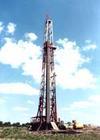
|
The production of formation sand into a well is one of the oldest problems plaguing the oil and gas industry because of its adverse effects on well productivity and equipment. It is normally associated with shallow, geologically young formations that have little or no natural cementation to hold the individual sand grains together. As a result, when the wellbore pressure is lower than the reservoir pressure, drag forces are applied to the formation sands as a consequence of fluid production. If the formation's restraining forces are exceeded, sand will be drawn into the wellbore. The sand either plugs the well or is produced. Produced sand has essentially no economic value. On the contrary, formation sand not only can plug wells, but also can erode equipment and settle in surface vessels. Controlling formation sand is costly and usually involves either slowing the production rate or using gravel packing or sand consolidation techniques. Operators spend millions of dollars each year to prevent the production of formation sand and to deal with other sand-related problems. Expenditures of this magnitude obviously have a significant impact on profits. In spite of these costs, effective sand-control practices have yielded oil and gas from wells that otherwise would have been shut-in. In deciding upon the most appropriate sand-control technique, the engineer must first be aware of the treatment options available and then select one according to the geometric factors and completion requirements of the particular well.
PGI has many experts to supply consulting services to you to help make decision.
|

